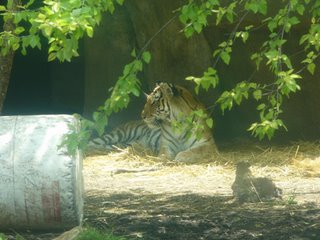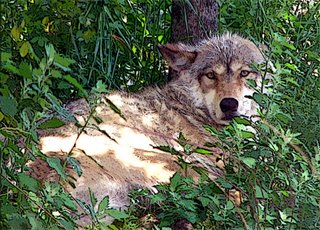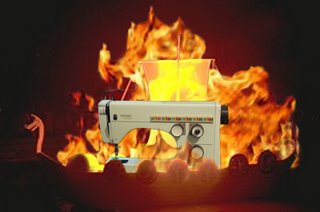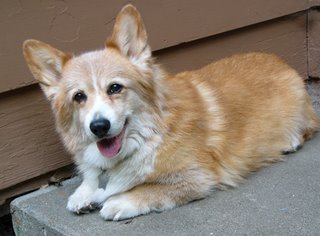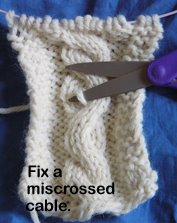It involves cutting a strand of yarn, so may seem scarier than other methods, but it allows an invisible fix, and is easier than dropping the cable back many many rows....
Here we have our miscrossed cable.

Here is the critical part -- which thread do we cut? If you look at the place where the index finger is really stretching out the yarn, you can see that the thread marked in hot pink is the row before the twist. Those stitches don't want to be there. They want to be in the middle of the cable, where they have happily been for the last few rows. The stitches marked in blue are the row where the twist was made. It's the strand marked in blue that we'll cut.
Choosing the right strand to cut is the only part of this whole scenario for which there is no do-over.

Having identified the right strand, we follow it to the middle of the cable. I checked that I had the right strand about 8 times. Then cut.
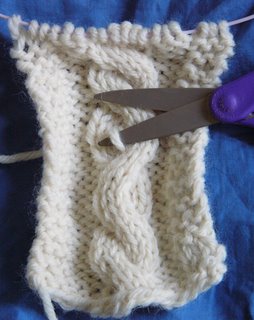
Now the worst is over. Unpick the cable from its middle to each side. I kept the freed stitches on extra needles. Three extras really would have done fine -- only one of the two rows will get twisted, so all six of the stitches in the row above the picked-out row could have started on one needle.

Now's when you put the cross back, with luck, in the right direction this time. Cross one set of three behind the other, and put all six stitches on one needle to hold the crossed stitches in place.

Now kitchener them up.
Weave in your ends, and, hey, presto!, an invisible fix.

Update, 7-4-06
For me, this is a lot less scary than a steek. Steeks scare me, because I know how often I must rip, and once I've cut all those strands.....
The difference, for me, between cutting a steek and this sort of repair, is that the repair involves cutting one (1) strand. Those two cut ends require one join each -- two (2) joins, total. Each cut end is joined to an end of the short piece I added when kitchenering. My continuous strand is maintained. So if I need to rip, I can. I could even eliminate the bit of yarn used for kitchenering and join the two cut ends of my original strand, if I did end up having to rip.
One more thought -- joins are easy to hide in a cabled fabric.........
Update, 7-5-06
I assumed the joins, rather than describing them. I'll rectify that now.....
What I do, generally, when I join two strands, is work both of them at the same time for two or three stitches, and come back after a few rows and weave in the ends. When I join two balls of yarn in the same project, that's what I usually do.
In this case, what I did was unpick just to the edge of the cable, but I began the kitchenering a couple of stitches further into the knitting. I worked duplicate stitch (in the same row as the cut strand) for a couple of stitches, then kitchenered the ends of the cable, then worked another couple of stitches of duplicate stitch at the other edge of the cable.
With a really slippery yarn, I bet it would be a good idea to have a knot. I've never used a really slippery yarn.... The test yarn was partly wool, and I guarantee you that those joined ends aren't going anywhere. Wool is a nice friendly fiber and wants to help you. It won't sneakily unravel itself, out of sheer meanness.
I urge you to knit a tiny swatch, and cut one thread in the middle. Then pull, pull, pull, viciously, in every direction, and see what happens. It's not anything like nylon stockings, which *zip* a terrible run while you watch in dismay. You may find that one stitch unravels, or two, and maybe one or two will run a few stitches in either direction, but you will need to work to make them do so. With wool in your yarn, I promise you it will be an annoyance rather than a disaster to mend. Not that you want to mend the swatch, though it would be excellent practice for mending a sweater, but *if* you wanted to mend it, it would be easy.
As Elizabeth Zimmermann said, I am the boss of my knitting. I recommend her book Knitting without Tears -- if you don't have it, check it out of the library and see, and I bet you'll want to add it to your library. EZ does an excellent job of making the mechanics of knitting clear and understandable.



